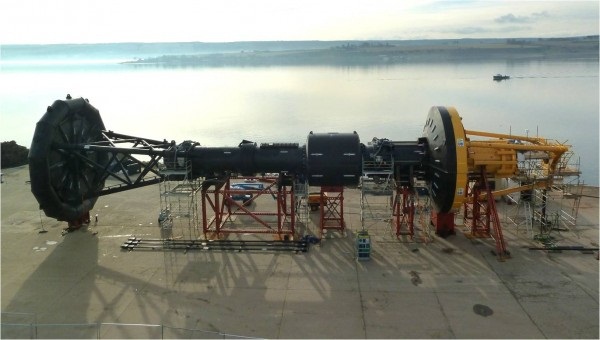The next big thing in wave power in the United States, expected to debut on the Pacific Ocean in the coming weeks, is going to spend the winter in dry dock in Portland.
Ocean Power Technologies, which had been aiming to make U.S. history by deploying its commercial, utility-scale PowerBuoy wave energy device off the Oregon coast before the rough seas of fall and winter arrived, said today it will wait until next spring.

The company’s chief technology officer, Phil Hart, deflated the crowd in announcing the delay during an OPT-sponsored lunch at the Ocean Renewable Energy Conference in Portland. Hart said the project had missed its window of opportunity and that to tow the massive buoy 300 miles south to its site two and half miles off the coast near Reedsport, Ore., in October would have been too risky.
“Nobody is more disappointed than we are,” Hart said in an interview after delivering the news to a crowd that included virtually the entire Oregon wave industry as well as national and international players and leading Oregon politicians, including Gov. John Kitzhaber and Rep. Suzanne Bonamici.
“We made the decision about two days ago, after a lot of agonizing,” Hart said. “With the growing uncertainty about the weather, the overriding concern is that it’s just not safe to go forward in October.”
Hart emphasized that there wasn’t any fear about the device withstanding the rigors of the wintertime Pacific once deployed; it was strictly a matter of being able to count on up to a full week of trouble-free weather in getting the device in place.
OPT, based in New Jersey, is the first company to be fully licensed to run a grid-connected wave power array in the U.S., at the Reedsport site. The company had hoped to have the initial PowerBuoy in the water in August this year, but a switch from a hydraulic power system to a mechanical one – considered less risky environmentally – slowed down the assembly and final testing of the PowerBuoy. Hart also cited weather-related delays recently in setting up the mooring system that will hold the PowerBuoy in place as factors in the postponement.
The impending deployment of the OPT device had shone a spotlight on the nascent wave energy industry in Oregon, capped off by a big New York Times feature earlier this month, even though much work remains, taking perhaps several years, before power from the ocean might actually make it ashore.
Once deployed, the lone PowerBuoy will have to spend at least a year in the water undergoing testing before work on a grid connection might begin. If all goes well — and that includes gaining additional funding — OPT hopes to eventually built out the Reedsport site with 10 PowerBuoys totaling 1.5 megawatts of generating capacity.
While the announcement surprised and disappointed conference attendees, Jason Busch, executive director of the Oregon Wave Energy trust, a state-backed nonprofit that has supported OPT with nearly a half-million dollars in grants, said it wasn’t a major setback. “Did we want to see it go in the water this summer? Absolutely,” Busch said. “Delaying until springtime was a close call, but in the end it was a smart decision. It’s a bit of a disappointment in the short-term, but if you step back and take a long-term view, the last thing that we wanted was to undertake a risky deployment that we couldn’t sure would be safe.”